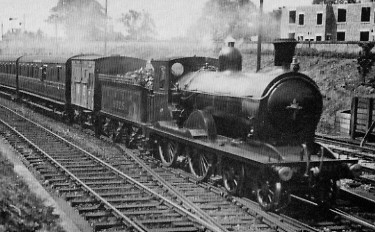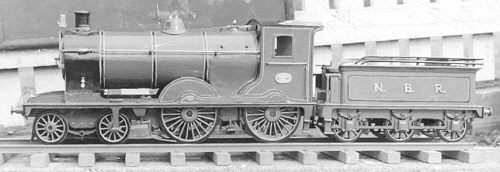The Holmes D26 (NBR Class K) 4-4-0 Locomotives

All of Holmes' passenger tender locomotives used the 4-4-0 wheel arrangement, but the North British Railway (NBR) Class K (LNER D26) were his final and greatest design. The twelve D26s were ordered in March 1902 and built at Cowlairs in 1903. Holmes died on 4th July 1903, and only saw the the first four D26s enter traffic.
The D26 design was based on Holmes' earlier NBR Class M (LNER D31) design. The boiler and firebox were both lengthened resulting in a longer coupled wheelbase. The cylinders were increased slightly in size to 19in diameter, and the slide valves were replaced with piston valves. The most significant visual difference was the use of a modern side-window cab. Reid is occasionally credited with some of the D26 design, but there is no evidence to support this and he was not at Cowlairs when the D26 was designed.
The D26s were never rebuilt and only received minor modifications during their lives. For example, Reid reduced the boiler pressure from 200psi to 190psi. Five D26s were fitted with tablet catchers for working over the Dundee to Aberdeen main line. All of the D26s were built with Westinghouse brakes, but six were dual fitted with vacuum ejectors by 1916.
The first six D26s were initially allocated to Aberdeen to haul the express passenger services to Edinburgh. The last six were allocated to St. Margaret's. Two of these worked the line towards Aberdeen, and the remaining four worked the line to Carlisle. After a short interval, two of these latter engines were moved to Carlisle.
Increasing train loads led to the introduction of larger 4-4-0s and Atlantics, and no further D26s were built. This is unfortunate as the D26s were well-regarded by the engine crews, and were capable of some hard work. The introduction of the Atlantics led to the D26s being displaced to the Glasgow and Perth trunk routes. However, they continued to haul occasional heavy main line services until after the D29 'Scotts' were introduced in 1909. After about 1915, the D26s were used on specials or as replacement engines, and did not have a regular roster. They were also seen double-heading Atlantics during this latter period.
The NBR usually rebuilt its locomotives when the original boilers were due for replacement. The D26s were considered for rebuilding in early 1922, but it was decided to withdraw them instead. The exact reasons for this decision are unknown, but it is known that their frames were in poor condition. It is possible that replacing both the boilers and frames was not economic - especially as Grouping (1923) was imminent. The first three D26s were withdrawn at the end of 1922. Nine D26s entered LNER ownership. The LNER continued the withdrawal programme, leaving one D26 (No. 9325) to survive into 1926. This was withdrawn in July 1926. Many of the D26s spent their last years working the Edinburgh to Glasgow service via Airdrie.
Technical Details
| Cylinders (x2): | (inside) | 19x26in. |
| Motion: | Stephenson | |
| Valves: | 8.75in piston | |
| Boiler: | Max. Diameter: | 4ft 8.125in |
| Pressure: | 190psi | |
| Heating Surface: | Total: | 1577 sq.ft. |
| Firebox: | 133 sq.ft. | |
| Tubes: | 1444 sq.ft. (254x 1.87in) | |
| Grate Area: | 22.5 sq.ft. | |
| Wheels: | Leading: | 3ft 6in |
| Coupled: | 6ft 6in | |
| Tender: | 4ft 0in | |
| Tractive Effort: | (@ 85% boiler pressure) | 19,434lb |
| Wheelbase: | Total: | 46ft 8.5in |
| Engine: | 23ft 7in | |
| Tender: | 13ft 6in | |
| Weight (full): | Total: | 92 tons 0cwt |
| Engine: | 52 tons 0cwt | |
| Tender: | 40 tons 0cwt | |
| Max. Axle Load: | 18 tons 6cwt |
Preservation
The last D26 was withdrawn in 1926, and none have survived into preservation.
Models

I am not aware of any ready to run or kit models of the D26 in any scale.
However the model of No.324 (above) was built by Richard Armstrong in 1910. Armstrong was based at St Margaret�s yard in Edinburgh where several of the D26s were based at the time. The model was displayed at Waverly Station, Edinburgh until 1950. It was subsequently moved (and thought to be lost) when improvements were made to the station. It is displayed at the Bo�ness Railway Museum outside Edinburgh although much of the information originally displayed with the model has been lost.
Acknowledgments
Thank you to Richard Austin Armstrong (Richard Armstrong's grandson) for the photograph of the model of No. 324, and to Richard Alasdair Armstrong (great grandson) for the accompanying information.